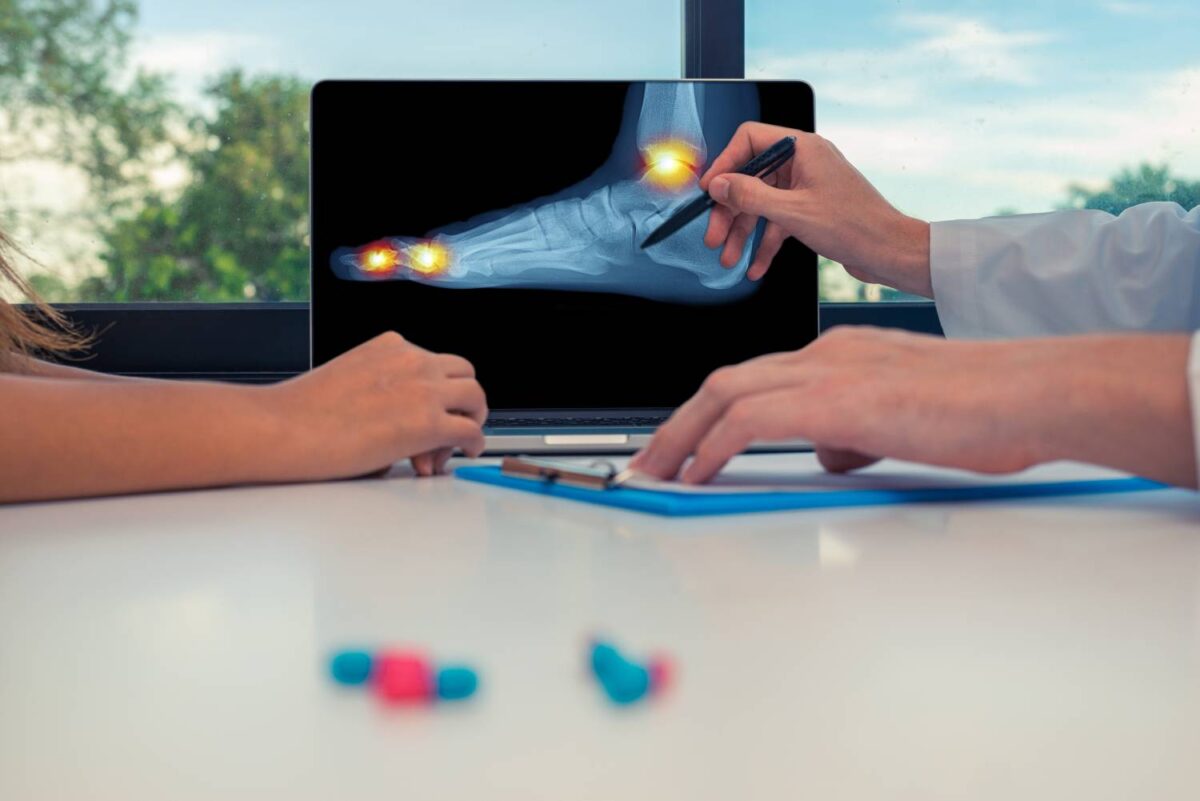Plantar Fasciitis: Physical Therapy for Foot Pain

Plantar Fasciitis (PF) is one of the most common causes of foot pain1,3. Studies estimate that PF accounts for “11 to 15 percent of all foot symptoms requiring professional care among adults1,3.” More specifically, Koteeswaran et al. find that PF is the cause of 80% of all cases reporting heel pain2. PF is generally defined as “inflammation and swelling of the plantar fascia, a dense band of tissue that runs across the bottom of the foot, starting at the back of the heel3.” It “is often caused by overuse, poor natural mechanics, overweight of the body, sports or unsuitable footwear,” and tends to be reported in people between the ages of forty and sixty years3.
Supplementary to the use of ice and heat1, several types of physical therapy have also been used to treat PF. Some of these include “massage, mobilization, therapeutic ultrasound, and taping5,” as well as stretching and strengthening of the muscles and ligaments surrounding the foot1,3,5. In a 2019 study, Thong-On et al. compared the effects of strengthening and stretching exercise programs for reducing pain and improving gait performance in patients diagnosed with PF. The strength program consisted of a toe curl, ankle evertor/invertor exercises, and a heel raise; the stretching program involved stretching the gastrocnemius and soleus muscles, as well as the plantar fascia5. While it was concluded that “both the strengthening and stretching exercise programs could reduce the pain and improve gait performance in patients with PF within 3 months5,” a closer inspection of the results revealed that “an additional benefit was gained from the heel raise exercise5.” The heel raise exercise, Thong-On et al. add, “improved the strength of both the ankle dorsiflexors and the plantar flexors, [and] increased the range of motion and stretched the calf and Achilles tendons5.”
A physical therapist may also recommend Active Release Technique (ART)—“a movement-based massage technique to solve soft tissues in the body, including the fascia, muscles, nerves and ligaments3”—and Myofascial Release Technique (MFR)—“a low-load, long-term stretch [that] usually includes slow, sustained pressure applied either directly or indirectly to restricted fascial layers3”—to help treat PF. Pragassame et al., in a 2019 study, compared the effectiveness of ART versus MFR on patients with PF. They determined that “both ART and MFR are effective in reducing pain and improving functional performance in patients with PF3.” Further, although both techniques resulted in similar improvements in functional performance, their findings showed that ART was more effective at reducing pain than MFR3.
Other approaches to treating PF include mechanical treatment (MT) options (i.e., shoe inserts, ankle-foot orthoses, tape and shoes4), corticosteroid injections6, low level laser therapy2, ultrasound therapy2, and, in some extreme cases (fewer than 5%), surgery1. Research performed by Schuitema et al., focusing on the efficacy of MT on patients with PF, found that “contoured full-length insoles are more effective in relieving symptoms related to PF than heel cups4,” and stated that “taping is an effective short-term treatment.” Several studies also list corticosteroid injections as a short-term benefit in some cases1,6.
The “reasonable approach to intervention [for patients with PF],” according to Buchbinder et al., in an article published in The New England Journal of Medicine, “is to start with patient-directed, low-risk, minimal-cost interventions, such as regularly stretching the calf muscle and the plantar fascia, avoiding flat shoes and walking barefoot, using over-the-counter arch supports and heel cushions, and limiting extended physical activities1.” Buchbinder et al. go on to affirm, “in more than 80% of patients, the symptoms will resolve within a year1.”
References
- Buchbinder, R., M.B., B.S., & F.R.A.C.P. (2004). Plantar fasciitis. The New England Journal of Medicine, 350(21), 2159-66. DOI: 10.1056/NEJMcp032745.
- Koteeswaran, K., Ramya, K., Rajeshwari, Muthiah, M., & Pandian, S. K. (2020). Effectiveness of Low Level Laser Therapy Versus Ultrasound Therapy with Plantar Fascia Stretching in Subjects with Plantar Fasciitis. Indian Journal of Public Health Research & Development, 11(1), 92–96. DOI: 10.37506/v11/i1/2020/ijphrd/193792.
- Pragassame, S.A., Mohandas, K.V.K., & Santhose, K.R. (2019). Effectiveness of Active Release Technique Versus Myofascial Release Technique on Patients with Plantar Fasciitis: A Comparative Study. Indian Journal of Public Health Research & Development, 10(10), 460–465. DOI: 10.5958/0976-5506.2019.02850.X.
- Schuitema, D., Greve, C., Postema, K., Dekker, R., & Hijmans, J. M. (2020). Effectiveness of Mechanical Treatment for Plantar Fasciitis: A Systematic Review. Journal of Sport Rehabilitation, 29(5), 657–674. DOI: 10.1123/jsr.2019-0036.
- Thong-On, S., Bovonsunthonchai, S., Vachalathiti, R., Intiravoranont, W., Suwannarat, S., & Smith, R. (2019). Effects of Strengthening and Stretching Exercises on the Temporospatial Gait Parameters in Patients With Plantar Fasciitis: A Randomized Controlled Trial. Annals of Rehabilitation Medicine, 43(6), 662–676. DOI: 10.5535/arm.2019.43.6.662.
- Whittaker, G. A., Munteanu, S. E., Menz, H. B., Bonanno, D. R., Gerrard, J. M., & Landorf, K. B. (2019). Corticosteroid injection for plantar heel pain: a systematic review and meta-analysis. BMC Musculoskeletal Disorders, 20(1), 378. DOI: 10.1186/s12891-019-2749-z.
